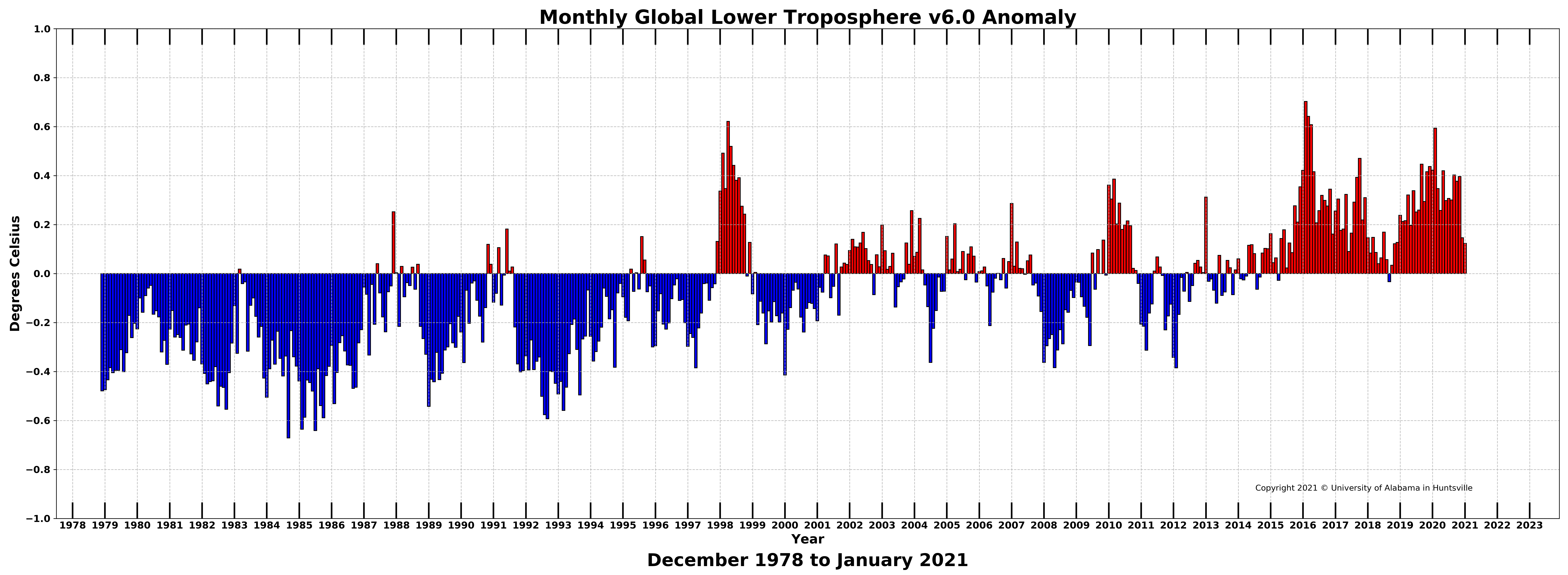Global Temperature Report: January 2021 with New Reference Base, 1991-2020
Global climate trend since Dec. 1 1978: +0.14 C per decade
January Temperatures (preliminary)
Global composite temp.: +0.12 C (+0.22 °F) above seasonal average
Northern Hemisphere: +0.34 C (+0.61 °F) above seasonal average
Southern Hemisphere: -0.09 C (-0.16 °F) below seasonal average
Tropics: -0.08 C (-0.14 °F) below seasonal average
December Temperatures (final)
Global composite temp.: +0.15 C (+0.27 °F) above seasonal average
Northern Hemisphere: +0.08 C (+0.14 °F) above seasonal average
Southern Hemisphere: +0.22 C (+0.40 °F) above seasonal average
Tropics: -0.07 °C (-0.13 °F) below seasonal average
Notes on data released February 2, 2021 (v6.0) with new reference base
As noted last month, the situation comes around every 10 years when the reference period or “30-year normal” that we use to calculate the departures is redefined. With that, we have averaged the absolute temperatures over the period 1991-2020, in accordance with the World Meteorological Organization’s guidelines, and use this as the new base period. This allows the anomalies to relate more closely to the experience of the average person, i.e. the climate of the last 30 years. Due to the rising trend of global and regional temperatures, the new normals are a little warmer than before, i.e. the global average temperature for Januaries for 1991-2020 is 0.14 °C warmer than the average for Januaries during 1981-2010. So, the new departures from this now warmer average will appear to be cooler, but this is an artifact of simply applying a new base period. It is important to remember that changes over time periods, such as a trend value or the relative difference of one year to the next, will not change. Think about it this way, all we’ve done is to take the entire time series and shifted it down a little.
For January 2021, the La Niña-induced cooling is still evident with relatively cool temperatures continuing to appear. As noted last year, if this La Niña develops as the past few have, we would expect a drop in global temperatures of about 0.3 °C in early 2021 from mid-year 2020. With the January departure from seasonal averages of +0.12 °C, the temperature is now cooler than last May-November by 0.24 °C. This is the coolest January since 2014.
Relative to December, the NH warmed up by +0.26 C while the SH cooled off by +0.31 °C, leaving the global average not much different between December and January; +0.15 °C vs. +0.12 °C respectively. The tropics really didn’t change at all, from -0.07 °C to -0.08 °C.
The warmest departure from average was +5.6 °C (+10.2 °F) in northern Quebec on the northeast side of Hudson Bay. This location was the center of a large warmer-than-average region with other relatively warm areas over the Sahara, Caspian Sea, southwest China, the central North Pacific Ocean and a few regions in the southern high latitudes.
The coldest departure from average was -4.1 °C (-7.4 °F) near the town of Neryungri in the Sakha Republic of northeastern Russia. Joining this area of colder temperatures was Europe, southern Australia, Antarctica and the La Niña pattern in the equatorial Pacific Ocean.
The conterminous U.S. was slightly above average (+0.36 °C, +0.65 °F), but with a warm Alaska, the 49-state average was +0.50 °C (+0.90 °F). [We don’t include Hawaii in the US results because its land area is less than that of a satellite grid square, so it would have virtually no impact on the overall national results.]
To-Do List: There has been a delay in our ability to utilize and merge the new generation of microwave sensors (ATMS) on the NPP and JPSS satellites. As of now, the calibration equations applied by the agency have changed at least twice, so that the data stream contains inhomogeneities which obviously impact the type of measurements we seek. We are hoping this is resolved soon with a dataset that is built with a single, consistent set of calibration equations. In addition, the current non-drifting satellite operated by the Europeans, MetOP-B, has not yet been adjusted or “neutralized” for its seasonal peculiarities related to its unique equatorial crossing time (0930). While these MetOP-B peculiarities do not affect the long-term global trend, they do introduce error within a particular year in specific locations over land.
As part of an ongoing joint project between UAH, NOAA and NASA, Christy and Dr. Roy Spencer, an ESSC principal scientist, use data gathered by advanced microwave sounding units on NOAA, NASA and European satellites to produce temperature readings for almost all regions of the Earth. This includes remote desert, ocean and rain forest areas where reliable climate data are not otherwise available. Drs. Danny Braswell Rob Junod assist in the preparation of these reports.
The satellite-based instruments measure the temperature of the atmosphere from the surface up to an altitude of about eight kilometers above sea level. Once the monthly temperature data are collected and processed, they are placed in a “public” computer file for immediate access by atmospheric scientists in the U.S. and abroad.
The complete version 6 lower troposphere dataset is available here:
http://www.nsstc.uah.edu/data/msu/v6.0/tlt/uahncdc_lt_6.0.txt
Archived color maps of local temperature anomalies are available on-line at:
http://nsstc.uah.edu/climate/
Neither Christy nor Spencer receives any research support or funding from oil, coal or industrial companies or organizations, or from any private or special interest groups. All of their climate research funding comes from federal and state grants or contracts.


